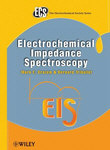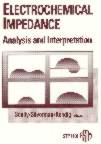The Bookstore
|
 |
Electrochemical Impedance Spectroscopy, or EIS, has come
into its own in the last twelve to fifteen years. I like to think that it is, in
part, due to the availability of commercial hardware and software that allow the
researcher to start taking data very easily. Interpretation of that data sometimes
takes a bit more skill. These volumes can help in that task!
Although they are out of print, also check Volume
1 and Volume 4 of the Bard "Electroanalytical
Chemistry" series. Both volumes have a chapter on EIS or related
topics.

"Electrochemical
Impedance Spectroscopy" (Electrochemical Society Series) by Mark E. Orazem, Bernard Tribollet
|
This book is the newest text on Impedance
Spectroscopy. Both authors are respected researchers in impedance,
and Orazem has been teaching a short course on impedance in conjunction
with ECS meetings
for several years.
If you were thinking of writing an
introductory textbook on EIS, it's too late. This looks like a great
book, quite easy to learn from. It is a bit lighter on the
applications, but it makes a great starter book and complements
Barsoukov & Macdonald nicely.
|
More Information...
 |
 
|
"Impedance Spectroscopy -
Theory, Experiment, and Applications, 2nd Edition" edited by
Barsoukov & Macdonald
|
|
This is a long awaited update to the nearly 20 year old first edition.
It contains new chapters on batteries, supercapacitors, and fuel
cells, areas where EIS has been more recently applied. These
chapters supplement the first edition's emphasis on materials
research. The new edition tips the scales at nearly 600 pages, a 50%
increase from the first edition. It is still heavily mathematical and
not light reading, but worth the effort.
The first edition of this book has been heavily used in
writing some of the topics on this website.
|
More Information...
 |
 
|
"Electrochemical Impedance" edited by Scully/Silverman/Kendig
|
|
This book is a compendium of chapters from a 1991 ASTM Symposium. Like
the first edition of the Macdonald book, it focuses primarily on
materials science. Nonetheless, it still contains several chapters
that will be worth reading by anyone who uses EIS.
|
More Information...
 |
|


